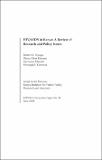| dc.date.accessioned | 2021-01-18T12:42:01Z | |
| dc.date.available | 2021-01-18T12:42:01Z | |
| dc.date.issued | 2004 | |
| dc.identifier.uri | http://repository.kippra.or.ke/handle/123456789/2585 | |
| dc.description.abstract | This paper examines the magnitude, distribution and causes of HIV/ AIDS in Kenya, including responses to fight the disease. An account is also provided of theoretical and empirical economics research approaches used in analysing the impact of HIV/AIDS. On average, statistics show that HIV/AIDS prevalence rates in urban areas are higher than in rural areas, and that HIV/AIDS is imposing heavy costs on the economy, primarily through increased medical care expenditure and labour losses. There are no strong indications that the epidemic is declining, casting doubts on the success of past anti-AIDS efforts. The true impact of awareness-creation campaigns in reducing new infections is still uncertain despite that most funds for intervention are channeled to these efforts. Medical treatment of AIDS patients, which can prolong life and prevent loss of productive labour, has received little attention or funding. | en |
| dc.language.iso | en | en |
| dc.publisher | The Kenya Institute for Public Policy Research and Analysis (KIPPRA) | en |
| dc.relation.ispartofseries | DP/38/2004 | |
| dc.subject | HIV & Aids | en |
| dc.subject | Micro-Level Effect | en |
| dc.subject | Meso- Level Effect | en |
| dc.subject | Epidemic Diseases | en |
| dc.subject | Kenya | en |
| dc.title | Discussion Paper No. 38 of 2004 on HIV/AIDS in Kenya: A Review of Research and Policy Issues | en |
| dc.type | KIPPRA Publications | en |
| ppr.contributor.author | Nyaga, Robert K.; Kimani, Diana Njeri,; Mwabu, Germano,; Kimenyi, Mwangi S. | en |

